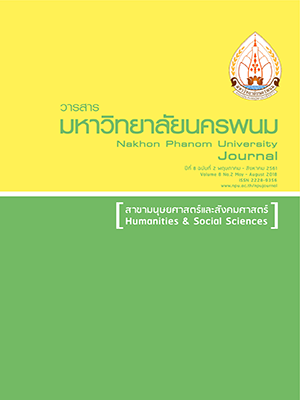การพัฒนาแนวทางการจัดสภาพแวดล้อมการเรียนรู้ภายในสถานศึกษาเอกชน สังกัดอัครสังฆมณฑลท่าแร่ หนองแสง
Main Article Content
Abstract
The purposes of this research were: 1) to find out the components and indicators of the desirable characteristics for internal learning environment in the private schools, 2) to examine the present state and desirable characteristics of internal learning environment in the private schools and 3) to develop a guideline to organize internal learning environment in the private schools of Tharae-Nongsaeng Archdiocese. There were two phases of mixed research. Phase 1 was to study the components and indicators of developing a guideline to manage internal learning environment by analyzing the documents and research related to the study. Five experts were interviewed for creating a conceptual framework of study. Phase 2 was to study the development of a guideline to manage internal learning environment within the schools. A sample was selected from the school administrators and teachers composing 265 people by using stratified random sampling method. The research instruments were a 5-rating scale questionnaire whose discrimination power values ranged between 0.37 and 0.74 and entire reliability coefficient was 0.96. Statistics used in research were mean, standard deviation and Modified Priority Needs Index (PNI modified).
The results of study were as follows: 1) The components of the desirable characteristics for internal learning environment in the private schools had 2 elements: (1) physical element: comprising 2 indicators – conditions outside and inside the classroom and (2) relationship element: comprising 2 indicators – relationships between teachers and administrators and between teachers and students. 2) The present state of organizing internal learning environment in the private schools of Tharae-Nongsaeng Archdiocese as a whole was at high level. The relationship element gained the highest mean. The desirable state appeared the same result as the present state. 3) The guideline to organize internal learning environment in the private schools of Tharae-Nongsaeng Archdiocese consisted of the following: (1) applying modern technology to achieve more efficiency and to be appropriate to current learning environment, (2) cultivating students about the importance of the environment that is appropriate to learning, (3) providing a training to educate the relevant personnel with the right environment for the students and creating a network to monitor and distribute useful information, (4) requiring teachers to lead the maintenance of the environment and (5) supervising, following up, evaluating and reporting results.
Article Details
References
กระทรวงศึกษาธิการ. (2545). พระราชบัญญัติการศึกษาแห่งชาติ พ.ศ.2542 และที่แก้ไขเพิ่มเติม (ฉบับที่ 2) พ.ศ.2545. กรุงเทพฯ : คุรุสภาลาดพร้าว.
กฤษณา ทบชิน. (2556). การจัดสภาพสิ่งแวดล้อมที่เอื้อต่อการเรียนรู้ของนักเรียนโรงเรียนบ้านไทรทอง สำนักงานเขตพื้นที่การศึกษาประถมศึกษาสระแก้ว เขต 1. สืบค้นเมื่อ พฤษภาคม 2560, จาก http://www.ptu.ac.th/ StudentServe/input/thesis/[1][080916042705].pdf
ชนัตถ์ พูนเดช. (2557). การพัฒนาโมเดลความสัมพันธ์เชิงสาเหตุระหว่างเป้าหมายแรงจูงใจใฝ่สัมฤทธิ์ การรับรู้สภาพแวดล้อมการเรียนรู้ในห้องเรียนสำหรับชั้นเรียนวิชาศึกษาทั่วไป วิธีการเรียนรู้ และการคิดอย่างมีวิจารณญาณ. วิทยาการวิจัยและวิทยาการปัญญา, 12(1), 1-14.
ธเนศ ขำเกิด. (2558). คุยเฟื่องเรื่องนิเทศการศึกษา 30 ประสบการณ์การนิเทศการศึกษาระดับเขตพื้นที่การศึกษาของ ผอ.กิตติพงศ์ ราชสิกข์/ธเนศ ขำเกิด. วิทยาจารย์, 114( 8), 20-23.
บุญชม ศรีสะอาด. (2554). การวิจัยเบื้องต้น. พิมพ์ครั้งที่ 7. กรุงเทพฯ : สุวีรียาสาสน์.
ประภัสสร บุญบำเรอ. (2560). การพัฒนารูปแบบการมีส่วนร่วมของคณะกรรมการบริหารโรงเรียนเอกชนภาคตะวันออกเฉียงเหนือสถานศึกษา. วารสารมหาวิทยาลัยนครพนม, 7(2), 27-35.
พรสวรรค์ วงค์ตาธรรม และสุมาลี ชัยเจริญ. (2558). ผลการตรวจสอบความตรงของรูปแบบสิ่งแวดล้อมทางการเรียนรู้แบบปฏิสัมพันธ์ส่งเสริมกระบวนการคิดแก้ปัญหาเชิงสร้างสรรค์สำหรับนักศึกษาสาขาคอมพิวเตอร์. วารสารวิชาการครุศาสตร์อุตสาหกรรม พระจอมเกล้าพระนครเหนือ, 7(2), 33-39.
สำนักอัครสังมณฑลท่าแร่หนองแสง. (2558). ข้อมูลสารสนเทศฝ่ายการศึกษา ปีการศึกษา 2558. สกลนคร : สมศักดิ์การพิมพ์สกลนคร.
สิริกูล กรอบบาง. (2557). การดำเนินการจัดสิ่งแวดล้อมของโรงเรียนมูลนิธิปากเกร็ดวิทยา อำเภอปากเกร็ด จังหวัดนนทบุรี. สืบค้นเมื่อ พฤษภาคม 2560, จาก http://www.ptu.ac.th/Student Servet/thesis/[1][080916042705].pdf.
Astin, A. W. (1968). The college environment. Washington D.C.: American Council on Education.
Catholic Education Council of Thailand. (2014). Articles of Catholic Schools into the Third Millennium 14. Bangkok : Assumption Printing Bang Rak. Retrieved May 2560, from http://www.ptu.ac.th/Student Serve/input/thesis/[1] [080916042705].pdf.
Savage, T.V., & Savage, M. K. (2010). Successful classroom management and discipline: Teaching self-control and responsibility (3rd Ed.). Los Angeles : SAGE Publications, Inc.
Yoddumnern-Attig, B., & Tangchonlatip, K. (2009). Qualitative analysis: Data management, interpretive explanation and finding the meaning. Nakhon Prathom : Institute for Population and Social Research.


